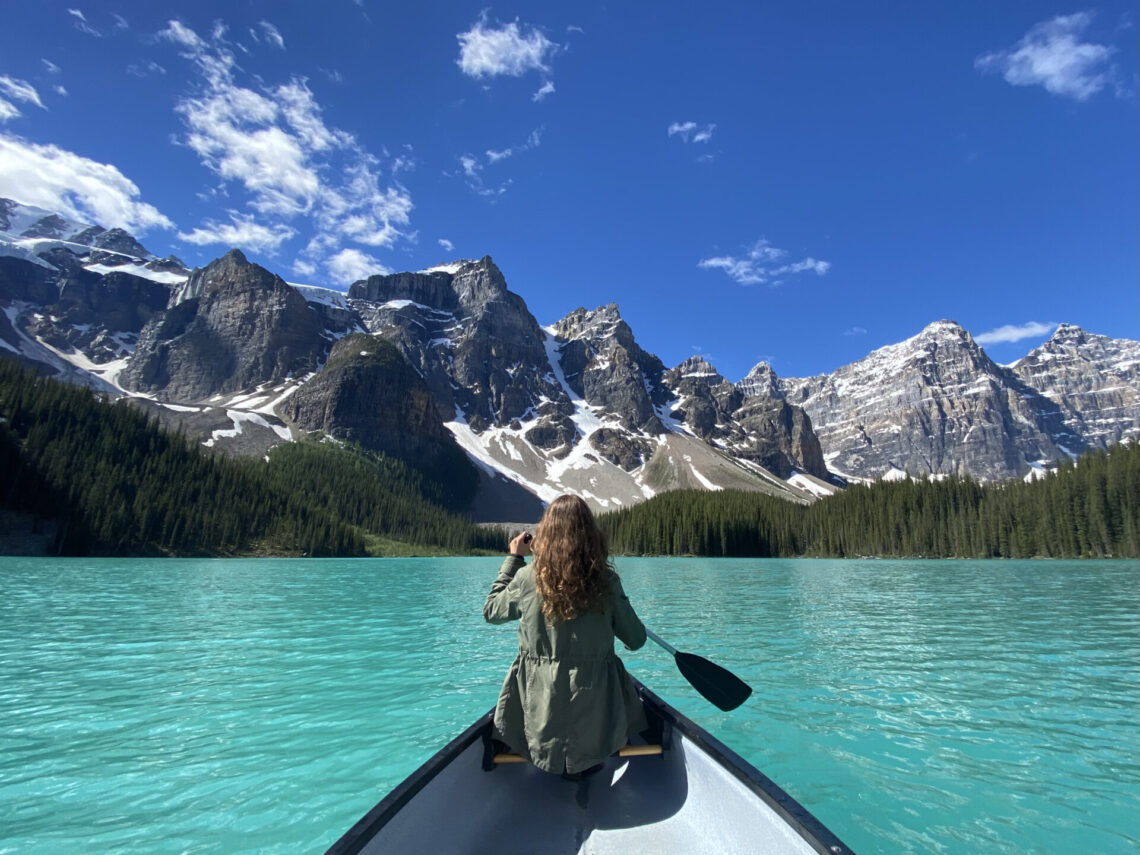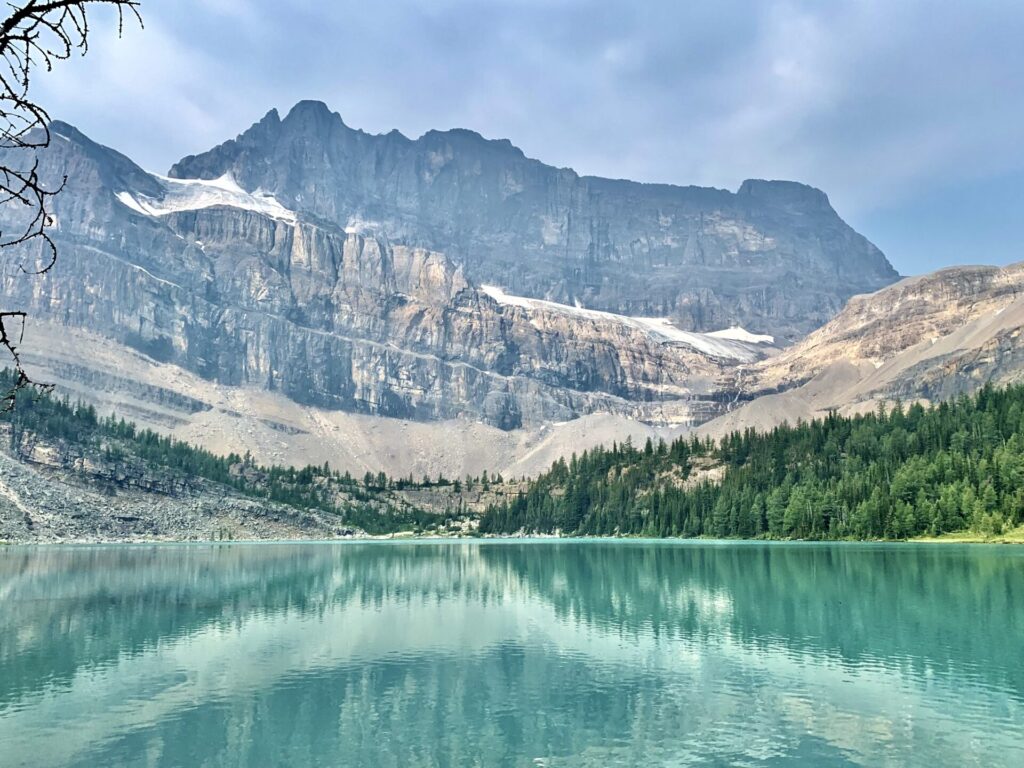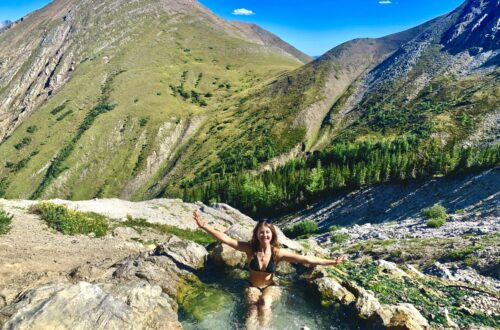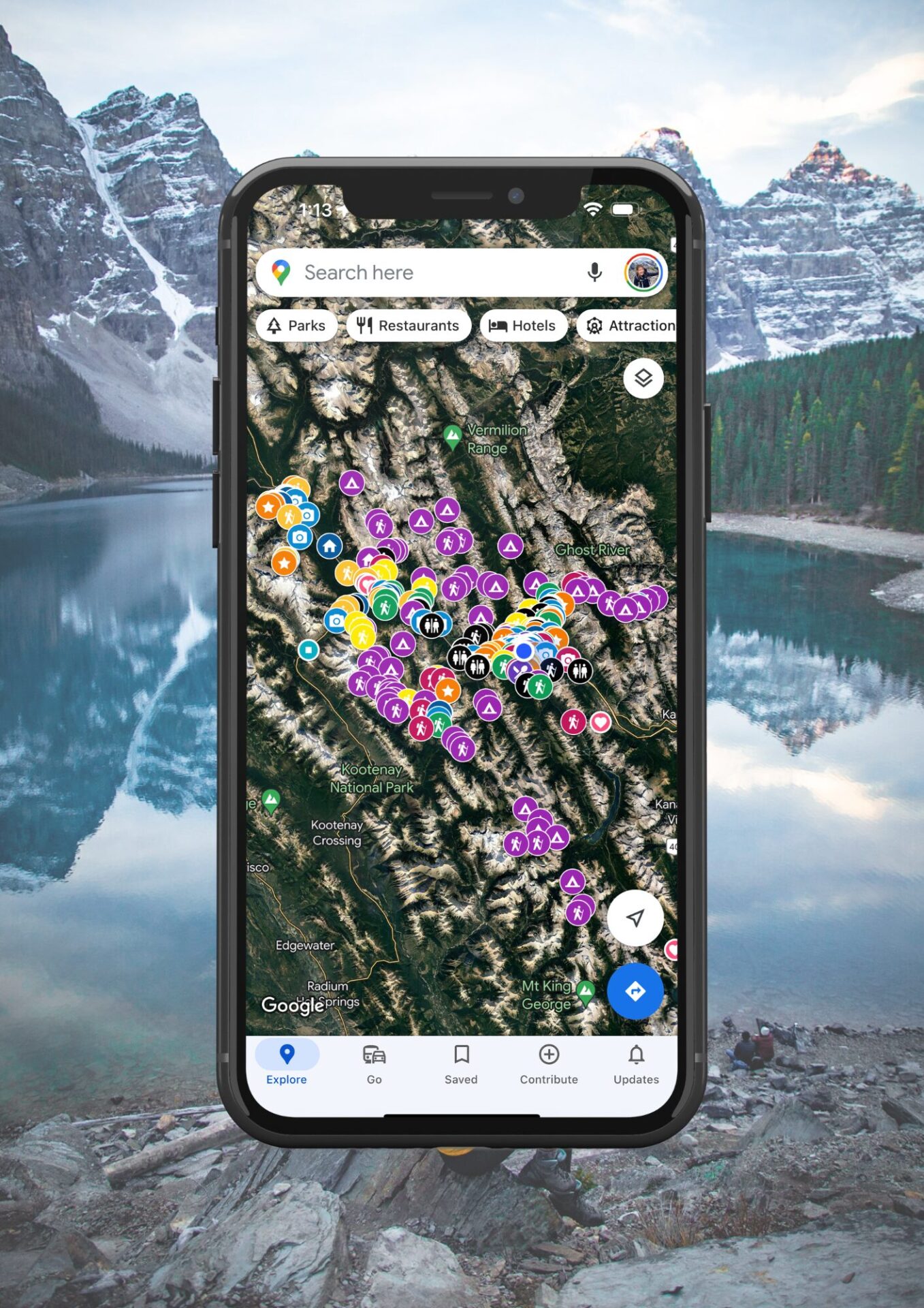
Planning a Trip to Banff: A Step by Step Guide
Planning a trip to Banff? You’ve come to the right place!
I lived in Banff for 15 months during 2020/2021 and spent my days hiking, skiing, camping, and exploring everything there was to explore.
I’ve since compiled everything I learned and experienced while living in Banff in order to help you plan the perfect trip. In this guide I’ll tell you everything you need to know about planning a trip to Banff, the best hikes, cheap ways to travel, and a few local’s secrets. But shhhh don’t tell anyone!
But before I get into my guide for planning a trip to Banff, make sure you check out these other incredible locations in the Rockies too:
- Jasper National Park
- Kananaskis Country
- Waterton Lakes National Park
- Yoho National Park
- British Columbia
Step 1: Find Directions to Banff
I’ll start my guide for planning a trip to Banff with directions.
Banff is located in Canada’s Rocky Mountains, specifically in the province of Alberta. Many travellers from Western Canada make the trek to Banff by car, however international travellers and those that live too far to drive need an alternate travel route.

For those that can’t drive, your best bet is to make your way to the biggest city nearby, Calgary (via plane; Calgary International Airport; YYC OR train Via Rail). After you arrive in Calgary, you’ll still need to travel an additional 1.5hrs before you arrive in Banff. The Banff website outlines a few options for travel between Calgary and Banff.
*As of summer 2021, Banff has implemented an entirely new, paid/permit style parking system. If you plan to drive to Banff, you can find information about parking here.
Local Transportation
Once you arrive in Banff, rather than driving take advantage of the Roam bus. The Roam bus is very inexpensive and offers routes to various places in and around town like Sulphur Mountain, Lake Louise, etc.
- Roam bus fares
- Transit routes
- Route 1 schedule: route 1 is the local route. Route 1 takes you down Banff Ave, to the Banff Gondola (Sulphur Mountain) and the Banff Upper Hot Springs.
- Lake Louise & or Lake shuttle information
planning a trip to banff
Step 2: Choose When to Visit Banff
Choosing when to visit is a key step in planning your trip to Banff.
ineThe aost popular time of year to visit Banff is undoubtedly summer, however each season in Banff offers something a little different. I was fortunate enough to experience each season when I lived in Banff and I can confirm – there are incredible activities year round in Banff you’ll love!


There are a million factors that influence weather and temperatures in Banff, however here’s generally what you can expect month-by-month in Banff:
planning a trip to banff
Summer Months in Banff
- June – snowcapped peaks, warming up in town, ice starts melting on lakes, hiking season begins (best for lower elevation hikes).
- July/August – most of the snow up in the mountains melts late July/early August. This is the best time of year for hiking, backpacking, and any type of water-based activity in Banff. You can also find wildflowers in Banff during these months; more on wildflowers here. The only downfall to visiting Banff during the summer are the huge crowds of tourists. Things can get prettyyyy crowded.

Fall in Banff
- September – September is typically still great for hiking (maybe not for big summits), and backpacking; although you’ll want to plan your trips earlier in September before temperatures drop at night. September is also Larch season (fall colours).
- October – October is a bit of a mixed bag. If the Rockies experience a warm(er) season, you can expect lots of outdoor activities to still be “do-able.” However if the Rockies experience a cold(er) season, October is a trick time to be in the Rockies as you can’t do much hiking and you can’t ski quite yet.

Planning a trip to banff
Winter in Banff
- November/December – the start of Banff’s 7 month ski season (yes 7 months)! Snow conditions are variable during the beginning of ski season, but the resorts are typically suitable for riding at this time. December is also the best month to skate on Banff’s frozen lakes before they’re covered in snow.
- January/February – These are the 2 coldest months in Banff, but they feature the most pow (ideal for skiers) and the most whiteout days (not ideal for skiers). There’s also normally a 1-2 week cold snap in January where temperatures consistently drop to -30 and lower.
- March/April/May – spring skiing! You can expect variable temperatures/conditions, however closer to May you’ll have consistent icy mornings and slushy afternoons up on the slopes. May marks the beginning of early hiking season. If you want to experience Banff in winter but aren’t a skier or snowboarder, visit in March. Temperatures will be a bit warmer, but you’ll still see the sparkly snowcapped peaks of the Rocky Mountains.

planning a trip to banff
Step 3: Plan your Banff Adventures
As you plan your trip to Banff, the most exciting part will undoubtedly be choosing the amazing adventures you’ll embark on. Banff offers something for everyone. If you’re an outdoor adventurer, view seeker, or mountain lounger, you’ll find what you’re looking for in this beautiful Canadian Park.
I could go on and on and on about all the incredible things to do in Banff. Rather than doing that though, I’ll point out a few highlights, link you to these tours, then direct you to my guides for summer and winter (listed below):
Summer Activities
Plan a Trip to Moraine Lake & Lake Louise

These are the two most iconic lakes in Banff. They are a bit tricky to get to, so you’ll have to do the following:
Lake Louise
- Drive a personal vehicle. Parking is $21/day at the lake and you must arrive 5am and earlier in peak season. Alternatively park at the Lake Louise ski resort and take the free shuttle to the lake.
- Make a reservation on the Roam bus; route 8X. These reservations fill up weeks in advance. You can also get walk-on spots if there’s space on the bus. Arrive 1hr+ early at the bus stop in peak season and have exact cash.
Moraine Lake
- Book a Superpass via Roam transit. You’ll have to go to Lake Louise first, then catch the Parks Canada connector shuttle to Moraine Lake.
- Book a sunrise shuttle via the Moraine Lake bus company. This is currently th only way to see sunrise at Moraine Lake.
- Bike the 12km (one-way) road in. Please note this road is in grizzly country and there are steep hills.
You can find more detailed information & more options for getting to Moraine Lake & Lake Louise here:
Accessible Hikes for Everyone in Banff:
Banff and the surrounding area has a massive and impressive amount of hiking trails. They’re clearly marked, well-trafficked, and suited for people of all ages and ability levels.
If you’re brand new to hiking, have small children, or if you have any kind of mobility issues I’d recommend these 12 easy hikes in Banff.
If you’re semi experienced and/or moderately fit I’d recommend checking out the Lake Louise Circuit (Lake Agnes and the Big Beehive in particular), Tunnel Mountain, Sulphur Mountain, and/or Larch Valley & Sentinel Pass.
If you’re an experienced hiker looking for a challenge I’d recommend Mount Bourgeau, the Sulphur Mountain Traverse Route, or Tower of Babel.
I want to also point out that Banff’s hiking trails aren’t limited to just Banff. Within 40 minutes of driving north or south from town you can find lots of other great hiking spots like Yoho, Kootenay, or my personal favourite Kananaskis Country.
Kananaskis Country is, in my opinion, the most beautiful hiking destination in the Rockies. The hikes in Kananaskis range from easy to mountaineering, but no matter what you’re hiking abilities are you’ll find trails that knock your socks off.
To find all of my Banff trail guides, click here.
If you want to check out my trail guides from all destinations, click here.

Quick recommendations: Things to do in Banff
Now I’ll give you some quick recommendations for things to do in Banff, but I recommend you check out this post for 50+ things to do in Banff in summer OR this post for 30+ things to do in Banff in winter – depending on when you’re visiting.
In these posts I write in depth about all the wonderful activities and excursions Banff offers along with GPS coordinates, photos, and additional information.
Hangout Spots in Banff
- Watch sunset from Norquay patch (just off Norquay drive) or the docks at Vermillion Lakes
- Party at Johnson Lake
- Have a bonfire at Banff’s Rec Grounds or Cascade Ponds
- Have a drink at the best patios in Banff: Peak Patio (Banff Gondola), Rose & Crown, Elk & Oarsman
Visit Banff’s Lakes
- The classics: Lake Louise, Moraine Lake, Lake Minnewanka, Peyto Lake
- Lesser known: Taylor Lake, Rockbound Lake, Boom Lake, Arnica & Twin Lakes
- Off-the-beaten path: Skoki Lakes, Glacier Lake
- Best for swimming: Johnson Lake, Herbert Lake, Two Jack Lake
Biking Trails
- Rent bikes at Bactrax in town
- The Banff Springs golf course loop
- Bike to Lake Minnewanka from town
- Highway 1A to Johnston Canyon
- Bike the Legacy trail (from Banff to Canmore)
Other Ideas
- Try rock climbing or a Via Ferrata
- Take the Banff Gondola up Sulphur Mountain
- Do a sunrise hike (Tunnel Mountain)
- Try horseback riding through the mountains
- Embark on the Lake Minnewanka boat cruise
- Rent canoes on the Bow River/Lake Minnewanka
- Go white water rafting in Golden
Explore Tours in Banff
If you’re one for excursions and adventures, check these out. There are various tour companies in Banff who put together sightseeing, adventure, and cultural activities. Booking a tour takes away the planning process and oftentimes includes amenities like shuttles, food, pictures, etc.
Step 4: Find a Place to Stay in Banff
Where to Stay in Banff
This post is my detailed breakdown of the best hotels in Banff – all organized by category.
Booking.com- Hostels – Samesun Banff (best location + bar/restaurant on-site), Banff International Hostel, and HI Banff.
- Budget stays – Bow View Lodge and High Country Inn.
- Mid-range stays – Banff Park Lodge, Mount Royal, Elk & Avenue, and the Banff Caribou & spa.
- Luxury stays – Fairmont Banff Springs and the Rimrock Resort.
- Camp – reservation information.
- See all Banff accommodations.
Travellers can also opt to stay in locations near Banff:
- Lake Louise – Fairmont Chateau Lake Louise (luxury), Paradise Lodge & Bungalows (500m from the lake), Lake Louise Inn (value stay), HI Lake Louise (hostel).
- Canmore – Malcolm Hotel (luxury), Stoneridge Mountain Resort (condo suites with fully equipped kitchens), Mountain View Inn (budget), Canmore Downtown Hostel & the Canmore Hostel (party hostel).
- Johnston Canyon – Johnston Canyon Lodge & Bungalows, Castle Mountain Chalets, and HI Castle Mountain Hostel.
- Yoho National Park – Emerald Lake Lodge and Cathedral Mountain Lodge.
- Kootenay National Park – Storm Mountain Lodge & Cabins.
- Kananaskis Country – Mount Engadine Lodge and Kananaskis Mountain Lodge (luxury), Crosswaters Resort (mid-range), and HI Kananaskis Wilderness Hostel (budget).
Planning a trip to Banff
Step 5: Plan Where to Eat in Banff
Banff offers sooo many restaurants and different food options. I’ll list a few of my favourites here, however this post outlines all the best places to eat in Banff.
If you’re on a budget, you’ll also want check out Taxi Mike while you plan your trip to Banff. Taxi Mike is run by a local who keeps up with all the Banff restaurant’s happy hour deals, daily deals, and other great opportunities to save $ on food.
Here are a few of my favourite places to eat in Banff:
- Breakfast/lunch: Juniper Bistro, Wildflour Bakery, Uprising Bakery.
- Yummy treats: Cows ice cream, Beaver Tails, The Fudgery.
- Dinner: Sky Bistro (honestly not my type of food, but fancy atmosphere), Eddie Burger (alcoholic milkshakes, YUM), Dominos (Banff has a serious pizza issue, this is literally the only good pizza in Banff), spinach dip at Earl’s, Nourish (vegan options), Magpie & Stump (Taco Tuesday), and the Bear Street Tavern.
- Drinks/patios: High Rollers, Park Distillery, Earl’s, Rose & Crown, The Dancing Sasquatch (nightclub), and Mel’s.
- Cultural food: The Balkan (Greek), Shoku Izakaya (Japanese), Hello Sunshine (Japanese/karaoke), Bamboo Garden (Chinese), El Toro (Spanish/Mexican), Magpie & Stump (Mexican), Indian; Masala, Saffron, Indian Curry House. Italian; Pacini, The Old Spaghetti Factory, La Terrazza, Ticino (Swiss/Italian).
Step 6: Choose What to Pack for Banff
Banff is located in Alberta’s Rocky Mountains. If you’ve been to the mountains before, you know mountain weather can change on a dime. For this reason, it’s imperative that you’re prepared for the elements. This is especially true if you’re planning to hike.
The best piece of advice I can give you is to pack layers: always. bring. a. jacket.
I’m going to break down what to pack for Banff into 3 categories: hiking, summer and winter. Honestly the seasons you get in between summer and winter are so short, I’m not even considering them seasons.

Banff Packing List: Hiking
I’ve created a few guides that outline everything you need to know for hiking in The Rockies. The following posts outline the best clothes for hiking, the best gear for hiking, and allllll the gear you need for a multi-night backcountry camping trip:
A few of my favourite items for hiking in The Rockies are:
- Waterproof jacket (men’s version)
- Puffer jacket (men’s version)
- Trekking poles
- Hydration reservoir
- Smartwool socks
planning a trip to banff
Banff Packing List: Summer
Packing for summer in Banff can be a tricky one. I spent 2 summers in Banff; one summer was freezing and I wore shorts maybe twice. The second summer I spent in Banff was HOT. I wore shorts and tank tops for months.
I’d recommend packing:
- A (one) cute summery outfit, maybe 2. Leave the heels and fancy clothes at home!
- Versatile summer clothing you can layer with; ie. cardigans or a zip fleece (I like this one for travel/men’s version)
- A jacket; I have my top picks for jackets here
- Pants; either hiking pants (my favourite pants/men’s version), durable leggings, or jeans
- Hiking boots (I use these/men’s version) or trail runners
- Thin gloves (I use these/men’s version)
- A toque/baseball cap
- A good day-pack (I use this one/men’s version)
Always check the weather before your trip and plan accordingly.

Banff Packing List: Winter
Winter in Banff is obviously cold (but dry cold). I’d recommend bringing a full winter set up (warm coat/snow pants), boots, as well as merino base layers and a warm toque. Additionally, a few of my favourite winter accessories and pieces of gear for Banff are:
- Ski mittens (I use these/men’s version)
- Soft-shell pants (men’s version); these are perfect for winter hiking, sightseeing, etc.
- Thermal socks
- Ski socks
- Winter hiking gear: micro-spikes and gaiters
If you’re planning to ski, make sure you bring extra clothes for layering as well as a buff or balaclava.
plan a trip to banff
Step 7: Add Locations Nearby to Your Trip
The Rockies feature soooo many incredible little towns and mountain ranges. Banff is the most iconic and world renown destination in the Rockies, but there are lots of little gems you surely won’t want to miss.
Consider adding some of the following destinations to your Banff bucket list:

Banff borders beautiful British Columbia; Canada’s westernmost province. British Columbia features picturesque mountains, vibrant lakes, and some gnarly skiing. One of my favourite National Parks in BC is Yoho, located just 40 minutes from Banff.

Kananaskis is located just 40 minutes from Banff and features my FAVOURITE hiking in The Rockies. There’s seriously something so special about the mountains, lakes, and wicked scrambling here. If you’re a hiker, be sure to check out my trail guides for Kananaskis before you set off for your Banff adventure.

Sitting in 2nd place for the most world renown National Park in Canada is Jasper. You can find all kinds of glaciers, beautiful lakes, hiking trails, and wildlife year round in Jasper, which is just a quick 3.5hr drive down the Icefields Parkway from Banff (one of the most beautiful drives in the world, by the way).
plan a trip to banff
Take it a Step Further: MOVE TO BANFF
For those people that love hiking and outdoor adventure, visiting Banff will only leave you wanting more. Literally the only way to scratch the itch you’ll feel after visiting Banff is to move there. I speak from experience.
So, for those looking to take their adventures to the next level, here are a few resources that’ll help you make the move to Banff:
- A Guide: Everything You Need to Know About Moving to Banff
- Working in Banff
- 6 Resources for Banff Locals
- 8 Things You Can Expect in Banff
- How to Live Sustainably in Banff and Canmore
Moving away from home to a little mountain town like Banff may seem intimidating at first, but I can assure you this’ll be the greatest adventure of your life. Banff is truly an INCREDIBLE place to live.
And that concludes my guide for planning a trip to Banff. Want to explore more?
Keep up With my Banff Adventures:
- Which Banff Ski Resort & Ski Pass is Best? A Full Review of SkiBig3
- What It’s Like to Work at Sunshine Village and the Banff Gondola & How to Find a Job in Banff
- Tunnel Mountain Hike – Banff National Park
- Tower of Babel Hike at Moraine Lake – Banff Scrambles
- Sulphur Mountain Traverse Route: An Off-the-Beaten Path Hike in Banff
- Sulphur Mountain Hike Guide + Gondola Information (Banff)
plan a trip to banff
Happy adventuring!
Taylor ♡
Like This Post?
Share with friends or save it for later!

About The Author
HI, I’m Taylor – the voice behind The Holistic Backpacker.
After moving to Banff National Park in 2020 I became an outdoor adventure enthusiast and vowed to never stop exploring.
I now spend my days travelling the world, climbing mountains, and spending nights under the stars in the Canadian Rockies backcountry.
I created The Holistic Backpacker so I could share my adventures and help connect people like you with the same amazing experiences.












